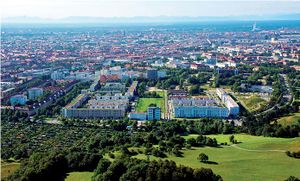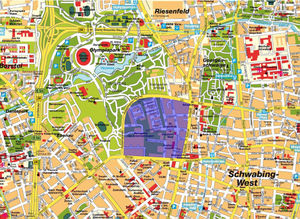Group O - Collaborative Climate Adaption Project
| Area | Munich | |
| Place | Ackermannbogen | |
| Country | Germany | |
| Topic | renewable energy application | |
| Author(s) | Cenke Jiang, Andreea Pascu, Le Trang Nguyen | |

| ||
|
| ||
Rationale: Why have you selected this case study area?
- Munich is the capital city of Bavaria, one of Germany's three largest cities with the population of 1.42 million people and has the strongest economy of the whole country. This is a globally cosmopolitan city and also has the leading renewable energy policy.
- Ackermannbogen is a district of Munich particularly planned to be one of the front-runners of solar district heating. This is a part of the city's aim: 100% renewable energy for Munich in 2015. This area is a perfect practical example of building a green enery system and an innovative concept of intergrating solar heating machines with green space.
Authors' perspectives
We all come from different background, but our aspirations meet where the climate is actually changing and we believe renewable energy and mitigation is the key solution for the future. We chose Ackermannbogen as a project-case study, more than a reality-case study, because it is a great project which was designed and currently being built and continually adjusted for the future. Our aim is to learn from such massive plan and to make our own proposals in the context of pre-designed but considering the factor of climate changing.
Landscape and/or urban context
In the late eighties, the city of Munich laid the foundation stone for a municipal policy committed to promoting renewable sources of energy by emphasising energy saving. As early as 1991, the Munich municipal council decided to concentrate on lowering CO2 emissions by 30% in 2005 and by 50% in 2010. So far, the City of Munich's climate protection policy has respected Kyoto protocol objectives even though this was not the case before they were defined.
Ackermannbogen district is situated within the context of the pre-planning area, Munich Olympic Park. Along with the whole concept of "Green Olympic Games" and the energy saving policy of Munich itself, Ackermannbogen specifically generates solar-powered local heating system with a seasonal heat storage facility has been developed for the Bavarian capital of Munich. The concept actually came from a competition of urban and landscape design ideas in 1998, conducted by the city of Munich. The central idea of the design was to create a community planner broad range of different types of housing - from double or terraced houses to apartment buildings.
Biogeography
Ackermannbogen lies on the elevated plains of Upper Bavaria, about 50 km north of the northern edge of the Alps, at an altitude of about 520 m (1,706.04 ft) ASL. The local rivers are the Isar and the Würm. The geography characteristics are similar to Northern Alpine Foreland. The northern part of this sandy plateau includes a highly fertile flint area which is no longer affected by the folding processes found in the Alps, while the southern part is covered with morainic hills. Between these are fields of fluvio-glacial out-wash, such as around Munich. Wherever these deposits get thinner, the ground water can permeate the gravel surface and flood the area, leading to marshes as in the north of Munich.
One of the significant characteristics of the biogeography of Munich area is: Although the city keeps expanding, not only the population or the accommodations increase but also artificial hills are made and city's forest are planted. Species and natural elements are reserved as much as possible. With the examples of Munich Riem area and the English Garten, the Botanischer Garten München-Nymphenburg, Ackermannbogen district inherits diverse Bavarian biogeography.
Land use
Within the Urban Development Action, till 2014 Ackermannbogen will then cover 39.5 hectares in total:
- ca. 2250 dwellings
- Student dormitory
- Kindergarten
- Public primary school
- Private school
- Medical centre
- Supermarket
- Retails, Cafeterias
- Cultural and neighborhood meeting
- Bridge Construction
- 9.2 hectares of public green spaces
- Large meadow
- Playground
- Hills
- City Forest
Overall character
The project area is located in the northern part of the district Neuhausen-Oberwiesenfeld in the north of Munich, close to the southern edge of the Olympic site and connects directly to the Schwabing district. It is bounded by the Ackerman Road to the west and north, the Deidesheimer, Saar and Winzererstraße the east and Schwere–Reichter–Straße in the south.
In the south of the Schwere–Reichter–Straße, there is another smaller and still unused barracks (Luitpold barracks), a small, self-contained residential development and several gas stations. Following this is an area with offices and public facilities extends (Infantry, Hess, Loth and Dachauerstraße).
The district Schwabing-West is in the east of the project area is a dense block development area. Further north is the Middle Ring, Frankfurter Ring and the business and industrial belt at Frankfurter Ring Barrier, an urban landscape lying there on the clearance.
This central location is near to the park and also requires attracktive planning for residents and visitors, which is challenging due to the expected high use pressure.
History and dynamics
The history of the whole area comes from the land named Oberwiesenfeld. Since the end of the 19th century, Oberwiesenfeld area had been the landing for balloons and airships, both military and civilian. With the increased volume of the aircraft Oberwiesenfeld was used in 1909 as the airfield. In 1927, the City of Munich signed contract for the expansion of the existing airfield to an airport divided the land along the Nymphenburg Biedersteiner channel.
Since 1931/1932 under the power of Prince Leopold, Oberwiesenfeld became a barrack and a military rally point. In the Third Reich there was a connection with the planned further northwest yard, then slaughterhouses and stockyards and a heating plant were built. Since 1972, the northern (and largest) part of the upper meadow area merged into Munich Olympic Park.
Then for the area under the name "am Ackermannbogen" urban planning began to reflect a part of the Prince Leopold Barracks, both of which are currently completed three sections. After the construction of the first section in the north east of the site, the building of the Department of Military Geography (MilGeo) which had been abandoned by the army then was reconstructed. In 2006/07 the former barracks building in the Stetten barracks were pulled down, whereupon the fourth section will be built next to the student dormitory at Schweren-Reiter street.
Based on the urban contract and development agreement between the property owners and the City of Munich, in the fall of 2002 the first section of the development and the construction of housing in Ackermannbogen started. The northeast neighborhood was constructed under the "Bavarian Future", a residential support program of the Free State of Bavaria, which implemented as a "model village" to try new ways of cost, environmental and social living in Bavaria. Here approximately 630 homes, a mixture of various types of houses and apartments, as well as a daycare center were realized. Another building on the north end of the large lawn with an integrated cooperative system for children is expected to be ready in spring 2007.
The third section (North-West district) is the model project implemented Solar local heating, or solar thermal energy and district heating. Three large underground storage tanks were placed to supply approximately 300 residential units.
In the south (second section), particularly along Schwere-Reiter street and in the northern part of the Adams-Lehmann-street, next to social housing and public service and high-priced condominiums, a health clinic and a day care center are planned.
In the southwest (fourth section, there is a "market square" and the shops and stores are grouped so that the new district is supplied accordingly. In this area there will be sheltered housing for the arising elderly. An existing building on the Schwere-Reiter street was converted into a dormitory. The development plan for the fourth section is still being considered and not decided yet.
Ratio of green/blue and sealed/built-up areas
Illustration: Map; sketches; short descriptive analyses
Cultural/social/political context
- Brief explanation of culture, political economy, legal framework
Illustration: Bullet points, image, background notes
Local Climate
- What are the climatic conditions at present? Have there been extreme weather events in the near past?
- Which changes are expected? Is there any evidence?
Illustration: Table or time line
Analysis of vulnerability
- If you consider these potential changes - which aspects/functions of your case study would be affected?
Illustration: Map/diagram/sketches/photos/background notes
Proposals for Climate Change Adaption
- How could your case study area become more resilient to climate change?
- Which measures would need to be taken to adapt to the new situation?
- How could you assure sustainability of these measures?
- Please describe 2-3 measures
Proposals for Climate Change Mitigation
- Which measures would need to be taken to reduce greenhouse gas emissions and other drivers of climate change within your case study area?
- How could you assure sustainability of these measures?
- Please describe 2-3 measures
Your scenario
- How will this area look like in 2060?
- Please forecast one potential future development taking climate change into account
Illustration: Map/diagram/sketches photos and background notes
What can be generalized from this case study?
- Are there any important theoretical insights?
- Which research questions does it generate?
- Short statement plus background notes
Presentation Slides
- Addnewimagename.jpg
Slide One
- Addnewimagename.jpg
Slide Two
- Addnewimagename.jpg
Slide Three
Image Gallery
- Yourimage.jpg
your image text
- Yourimage.jpg
your image text
- Yourimage.jpg
your image text
- Yourimage.jpg
your image text
- Yourimage.jpg
your image text
- Yourimage.jpg
your image text
- Yourimage.jpg
your image text
- Yourimage.jpg
your image text
References
Please add literature, documentations and weblinks
About categories: You can add more categories with this tag: "", add your categories
